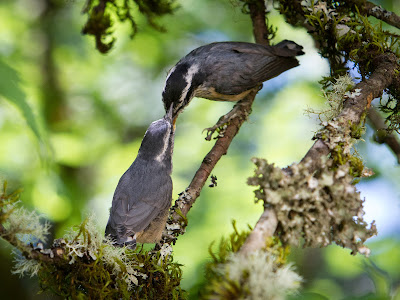There’s a small blue-slate colored bird with a striped head moving quickly along the trunk of my cedar tree - sometimes headfirst, then zig-zagging sideways then downward again.
It repeatedly stops and energetically pokes into crevasses looking for bugs. The tree and the bird like each other - the bird finds its meals while helping to keep the tree healthy.
The Red-breasted Nuthatch is sort of a noisy bird - its contact calls sound like a tiny tin-horn. It doesn’t really have a song as most people think of bird songs. When it gets excited it makes a series of yank-yank calls.
The Red-breasted Nuthatch is sort of a noisy bird - its contact calls sound like a tiny tin-horn. It doesn’t really have a song as most people think of bird songs. When it gets excited it makes a series of yank-yank calls.
 |
| Female feeding nestling. Note the resin around the nest hole. Photo by Craig Kerns |
They try to find softer or dead parts of trees for their excavations (you can help by creating a wildlife tree from a dying tree).
The pair are usually monogamous, with the male feeding the female while she sits on the 5-8 eggs for about 2 weeks.
They readily come to seed feeders and suet. They love black oil seeds and mealworms.
They will use nest boxes but are fussy about size and aging. It is better to put out a nest box in the fall so that it will age over the winter (and local birds can use it for winter shelter).
After lining the nest with grass, pine needles, fur and feathers, for some reason the pair will smear tree pitch around the opening.
These birds have been known to use a piece of bark to spread this resin - crows aren’t the only birds that can use tools. The adults fly directly into the nest during brooding to avoid contact with their applied nest protection.
 |
| The male feeds the female while she sits on the eggs Photo by Craig Kerns |
Both feed their young for the 18-21 days in the nest, and then for the first two weeks after they fledge.
When the female is on her nest she is mostly silent. When the nestlings fledge, those tiny tin- horn sounds abound. A person can locate the newly hatched brood by following their calls.
In the wintertime these short-distance flyers join chickadees and other small birds for successful winter foraging. These nuthatches eat seeds and insects (like spiders and earwigs) and will store winter supplies in bark crevices.
When the female is on her nest she is mostly silent. When the nestlings fledge, those tiny tin- horn sounds abound. A person can locate the newly hatched brood by following their calls.
In the wintertime these short-distance flyers join chickadees and other small birds for successful winter foraging. These nuthatches eat seeds and insects (like spiders and earwigs) and will store winter supplies in bark crevices.
 |
| Male eating suet. This is a typical pose. Photo by Craig Kerns |
They will use nest boxes but are fussy about size and aging. It is better to put out a nest box in the fall so that it will age over the winter (and local birds can use it for winter shelter).
A preferred nest box mimics a cavity like the nuthatch would excavate.
See previous For the Birds columns by Christine Southwick HERE
See previous For the Birds columns by Christine Southwick HERE


No comments:
Post a Comment
We encourage the thoughtful sharing of information and ideas. We expect comments to be civil and respectful, with no personal attacks or offensive language. We reserve the right to delete any comment.